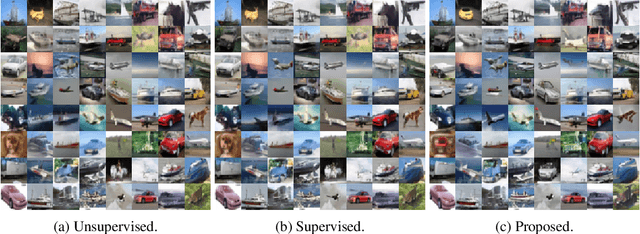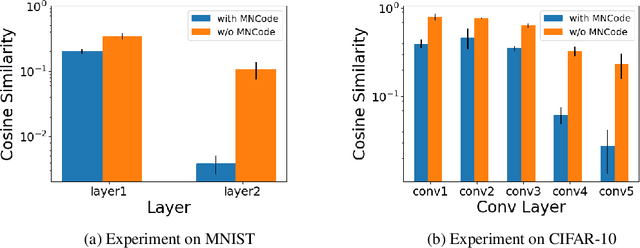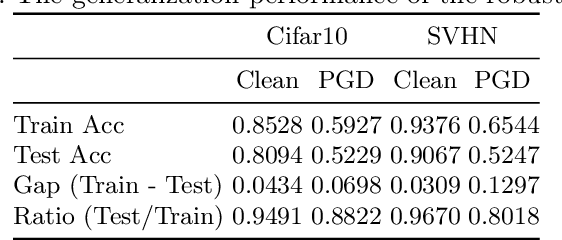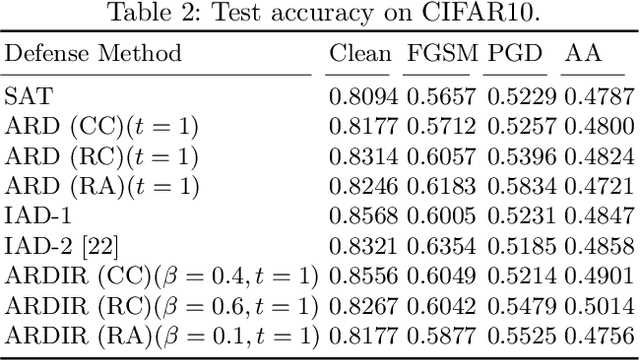Tomoya Yamashita
Sparse-Autoencoder-Guided Internal Representation Unlearning for Large Language Models
Sep 19, 2025Abstract:As large language models (LLMs) are increasingly deployed across various applications, privacy and copyright concerns have heightened the need for more effective LLM unlearning techniques. Many existing unlearning methods aim to suppress undesirable outputs through additional training (e.g., gradient ascent), which reduces the probability of generating such outputs. While such suppression-based approaches can control model outputs, they may not eliminate the underlying knowledge embedded in the model's internal activations; muting a response is not the same as forgetting it. Moreover, such suppression-based methods often suffer from model collapse. To address these issues, we propose a novel unlearning method that directly intervenes in the model's internal activations. In our formulation, forgetting is defined as a state in which the activation of a forgotten target is indistinguishable from that of ``unknown'' entities. Our method introduces an unlearning objective that modifies the activation of the target entity away from those of known entities and toward those of unknown entities in a sparse autoencoder latent space. By aligning the target's internal activation with those of unknown entities, we shift the model's recognition of the target entity from ``known'' to ``unknown'', achieving genuine forgetting while avoiding over-suppression and model collapse. Empirically, we show that our method effectively aligns the internal activations of the forgotten target, a result that the suppression-based approaches do not reliably achieve. Additionally, our method effectively reduces the model's recall of target knowledge in question-answering tasks without significant damage to the non-target knowledge.
Concept Unlearning in Large Language Models via Self-Constructed Knowledge Triplets
Sep 19, 2025Abstract:Machine Unlearning (MU) has recently attracted considerable attention as a solution to privacy and copyright issues in large language models (LLMs). Existing MU methods aim to remove specific target sentences from an LLM while minimizing damage to unrelated knowledge. However, these approaches require explicit target sentences and do not support removing broader concepts, such as persons or events. To address this limitation, we introduce Concept Unlearning (CU) as a new requirement for LLM unlearning. We leverage knowledge graphs to represent the LLM's internal knowledge and define CU as removing the forgetting target nodes and associated edges. This graph-based formulation enables a more intuitive unlearning and facilitates the design of more effective methods. We propose a novel method that prompts the LLM to generate knowledge triplets and explanatory sentences about the forgetting target and applies the unlearning process to these representations. Our approach enables more precise and comprehensive concept removal by aligning the unlearning process with the LLM's internal knowledge representations. Experiments on real-world and synthetic datasets demonstrate that our method effectively achieves concept-level unlearning while preserving unrelated knowledge.
Positive-Unlabeled Diffusion Models for Preventing Sensitive Data Generation
Mar 05, 2025



Abstract:Diffusion models are powerful generative models but often generate sensitive data that are unwanted by users, mainly because the unlabeled training data frequently contain such sensitive data. Since labeling all sensitive data in the large-scale unlabeled training data is impractical, we address this problem by using a small amount of labeled sensitive data. In this paper, we propose positive-unlabeled diffusion models, which prevent the generation of sensitive data using unlabeled and sensitive data. Our approach can approximate the evidence lower bound (ELBO) for normal (negative) data using only unlabeled and sensitive (positive) data. Therefore, even without labeled normal data, we can maximize the ELBO for normal data and minimize it for labeled sensitive data, ensuring the generation of only normal data. Through experiments across various datasets and settings, we demonstrated that our approach can prevent the generation of sensitive images without compromising image quality.
Revisiting Permutation Symmetry for Merging Models between Different Datasets
Jun 09, 2023Abstract:Model merging is a new approach to creating a new model by combining the weights of different trained models. Previous studies report that model merging works well for models trained on a single dataset with different random seeds, while model merging between different datasets is difficult. Merging knowledge from different datasets has practical significance, but it has not been well investigated. In this paper, we investigate the properties of merging models between different datasets. Through theoretical and empirical analyses, we find that the accuracy of the merged model decreases more significantly as the datasets diverge more and that the different loss landscapes for each dataset make model merging between different datasets difficult. We also show that merged models require datasets for merging in order to achieve a high accuracy. Furthermore, we show that condensed datasets created by dataset condensation can be used as substitutes for the original datasets when merging models. We conduct experiments for model merging between different datasets. When merging between MNIST and Fashion- MNIST models, the accuracy significantly improves by 28% using the dataset and 25% using the condensed dataset compared with not using the dataset.
One-Shot Machine Unlearning with Mnemonic Code
Jun 09, 2023



Abstract:Deep learning has achieved significant improvements in accuracy and has been applied to various fields. With the spread of deep learning, a new problem has also emerged; deep learning models can sometimes have undesirable information from an ethical standpoint. This problem must be resolved if deep learning is to make sensitive decisions such as hiring and prison sentencing. Machine unlearning (MU) is the research area that responds to such demands. MU aims at forgetting about undesirable training data from a trained deep learning model. A naive MU approach is to re-train the whole model with the training data from which the undesirable data has been removed. However, re-training the whole model can take a huge amount of time and consumes significant computer resources. To make MU even more practical, a simple-yet-effective MU method is required. In this paper, we propose a one-shot MU method, which does not need additional training. To design one-shot MU, we add noise to the model parameters that are sensitive to undesirable information. In our proposed method, we use the Fisher information matrix (FIM) to estimate the sensitive model parameters. Training data were usually used to evaluate the FIM in existing methods. In contrast, we avoid the need to retain the training data for calculating the FIM by using class-specific synthetic signals called mnemonic code. Extensive experiments using artificial and natural datasets demonstrate that our method outperforms the existing methods.
ARDIR: Improving Robustness using Knowledge Distillation of Internal Representation
Nov 01, 2022



Abstract:Adversarial training is the most promising method for learning robust models against adversarial examples. A recent study has shown that knowledge distillation between the same architectures is effective in improving the performance of adversarial training. Exploiting knowledge distillation is a new approach to improve adversarial training and has attracted much attention. However, its performance is still insufficient. Therefore, we propose Adversarial Robust Distillation with Internal Representation~(ARDIR) to utilize knowledge distillation even more effectively. In addition to the output of the teacher model, ARDIR uses the internal representation of the teacher model as a label for adversarial training. This enables the student model to be trained with richer, more informative labels. As a result, ARDIR can learn more robust student models. We show that ARDIR outperforms previous methods in our experiments.
 Add to Chrome
Add to Chrome Add to Firefox
Add to Firefox Add to Edge
Add to Edge